Economic Risk Assessment by Weather-Related Heat Stress Indices for Confined Livestock Buildings: A Case Study for Fattening Pigs in Central Europe
Abstract
1. Introduction
2. Materials and Methods
2.1. Likelihood of HS Inside Livestock Builings
2.2. Economic Impact of HS
3. Results
3.1. Relationship between Indoor-Related and Weather-Related Heat Stress Indices
3.2. Consequence of Global Warming on the Likelihood of Heat Stress Indices
3.3. Consequence of Global Warming on Extreme Values of Heat Stress Indices
3.4. Economic Risk for Pig Farms due to Global Warming
4. Discussion
5. Conclusions
Author Contributions
Funding
Institutional Review Board Statement
Informed Consent Statement
Data Availability Statement
Acknowledgments
Conflicts of Interest
References
- Murray-Tortarolo, G.N.; Jaramillo, V.J. The impact of extreme weather events on livestock populations: The case of the 2011 drought in Mexico. Clim. Chang. 2019. [Google Scholar] [CrossRef]
- COPA-COGECA. Assessment of the Impact of the Heat Wave and Drought of the Summer 2003 on Agricultural and Forestry; Comitêdês Organisations Professionalles de la Agricoles de la Communité Européenne/Comitê General de la Cooperation Agricole: Köln, Germany, 2004. [Google Scholar]
- Nardone, A.; Ronchi, B.; Lacetera, N.; Ranieri, M.S.; Bernabucci, U. Effects of climate changes on animal production and sustainability of livestock systems. Livest. Sci. 2010, 130, 57–69. [Google Scholar] [CrossRef]
- Özkan, Ş.; Vitali, A.; Lacetera, N.; Amon, B.; Bannink, A.; Bartley, D.J.; Blanco-Penedo, I.; De Haas, Y.; Dufrasne, I.; Elliott, J.; et al. Challenges and priorities for modelling livestock health and pathogens in the context of climate change. Environ. Res. 2016, 151, 130–144. [Google Scholar] [CrossRef] [PubMed]
- Bett, B.; Kiunga, P.; Gachohi, J.; Sindato, C.; Mbotha, D.; Robinson, T.; Lindahl, J.; Grace, D. Effects of climate change on the occurrence and distribution of livestock diseases. Prev. Vet. Med. 2017, 137, 119–129. [Google Scholar] [CrossRef]
- Morgan, E.R.; Wall, R. Climate change and parasitic disease: Farmer mitigation? Trends Parasitol. 2009, 25, 308–313. [Google Scholar] [CrossRef]
- Wall, R.; Rose, H.; Ellse, L.; Morgan, E. Livestock ectoparasites: Integrated management in a changing climate. Vet. Parasitol. 2011, 180, 82–89. [Google Scholar] [CrossRef]
- Van Dijk, J.; Sargison, N.D.; Kenyon, F.; Skuce, P.J. Climate change and infectious disease: Helminthological challenges to farmed ruminants in temperate regions. Animal 2010, 4, 377–392. [Google Scholar] [CrossRef]
- Skuce, P.J.; Morgan, E.R.; Van Dijk, J.; Mitchell, M. Animal health aspects of adaptation to climate change: Beating the heat and parasites in a warming Europe. Animal 2013, 7 (Suppl. 2), 333–345. [Google Scholar] [CrossRef]
- Hatfield, J.L.; Antle, J.; Garrett, K.A.; Izaurralde, R.C.; Mader, T.; Marshall, E.; Nearing, M.; Philip Robertson, G.; Ziska, L. Indicators of climate change in agricultural systems. Clim. Chang. 2018, 1–14. [Google Scholar] [CrossRef]
- Mikovits, C.; Zollitsch, W.; Hörtenhuber, S.J.; Baumgartner, J.; Niebuhr, K.; Piringer, M.; Anders, I.; Andre, K.; Hennig-Pauka, I.; Schönhart, M.; et al. Impacts of global warming on confined livestock systems for growing-fattening pigs: Simulation of heat stress for 1981 to 2017 in Central Europe. Int. J. Biometeorol. 2019, 63, 221–230. [Google Scholar] [CrossRef]
- Godde, C.M.; Mason-D’Croz, D.; Mayberry, D.E.; Thornton, P.K.; Herrero, M. Impacts of climate change on the livestock food supply chain; a review of the evidence. Glob. Food Secur. 2021, 28. [Google Scholar] [CrossRef]
- Bjerg, B.; Brandt, P.; Pedersen, P.; Zhang, G. Sows’ responses to increased heat load–A review. J. Therm. Biol. 2020, 94. [Google Scholar] [CrossRef] [PubMed]
- Hansen, R.K.; Bjerg, B. Optimal ambient Temperature with regard to Feed Efficiency and Daily Gain of finisher pigs. In Proceedings of the EurAgEng 2018 Conference, Wageningen, The Netherlands, 8–12 July 2018; pp. 8–12. [Google Scholar]
- Renaudeau, D.; Collin, A.; Yahav, S.; De Basilio, V.; Gourdine, J.L.; Collier, R.J. Adaptation to hot climate and strategies to alleviate heat stress in livestock production. Animal 2012, 6, 707–728. [Google Scholar] [CrossRef] [PubMed]
- Quiniou, N.; Dubois, S.; Noblet, J. Voluntary feed intake and feeding behaviour of group-housed growing pigs are affected by ambient temperature and body weight. Livest. Prod. Sci. 2000, 63, 245–253. [Google Scholar] [CrossRef]
- Johnson, J.S. Heat stress: Impact on livestock well-being and productivity and mitigation strategies to alleviate the negative effects. Anim. Prod. Sci. 2018, 58, 1404–1413. [Google Scholar] [CrossRef]
- Lacetera, N. Impact of climate change on animal health and welfare. Anim. Front. 2019, 1, 26–31. [Google Scholar] [CrossRef]
- Geers, R.; Berckmans, D.; Goedseels, V.; Wijnhoven, J.; Maes, F. A case-study of fattening pigs in Belgian contract farming. Mortality, efficiency of food utilization and carcass value of growing pigs, in relation to environmental engineering and control. Anim. Prod. 1984, 38, 105–111. [Google Scholar] [CrossRef]
- D’Allaire, S.; Drolet, R.; Brodeur, D. Sow mortality associated with high ambient temperatures. Can. Vet. J. 1996, 37, 237–239. [Google Scholar]
- Stalder, K.J. 2014 U.S. Pork Industry Productivity Analysis; National Pork Board: Des Moines, IA, USA, 2014.
- Agostini, P.; Fahey, A.; Manzanilla, E.; O’Doherty, J.; De Blas, C.; Gasa, J. Management factors affecting mortality, feed intake and feed conversion ratio of grow-finishing pigs. Animal 2014, 8, 1312–1318. [Google Scholar] [CrossRef]
- Maes, D.; Larriestra, A.; Deen, J.; Morrison, R. A retrospective study of mortality in grow-finish pigs in a multi-site production system. J. Swine Health Prod. 2001, 9, 267–273. [Google Scholar]
- King, D.; Schrag, D.; Dadi, Z.; Ye, Q.; Ghosh, A. Climate Change: A Risk Assessment; Centre for Science and Policy (CSaP) at the University of Cambridge: Cambridge, UK, 2017. [Google Scholar]
- Schauberger, G.; Mikovits, C.; Zollitsch, W.; Hörtenhuber, S.J.; Baumgartner, J.; Niebuhr, K.; Piringer, M.; Knauder, W.; Anders, I.; Andre, K.; et al. Global warming impact in confined livestock buildings: Efficacy of adaptation measures to reduce heat stress for growing-fattening pigs. Clim. Chang. 2019, 156, 567–587. [Google Scholar] [CrossRef]
- Godyń, D.; Herbut, P.; Angrecka, S.; Corrêa Vieira, F.M. Use of different cooling methods in pig facilities to alleviate the effects of heat stress-a review. Animals 2020, 10, 1459. [Google Scholar] [CrossRef] [PubMed]
- Gauly, M.; Ammer, S. Review: Challenges for dairy cow production systems arising from climate changes. Animal 2020, 14, S196–S203. [Google Scholar] [CrossRef] [PubMed]
- Bjerg, B.; Brandt, P.; Sørensen, K.; Pedersen, P.; Zhang, G. Review of methods to mitigate heat stress among sows. In Proceedings of the 2019 ASABE Annual International Meeting, Boston, MT, USA, 7–10 July 2019; pp. 1–10. [Google Scholar]
- Schauberger, G.; Hennig-Pauka, I.; Zollitsch, W.; Hörtenhuber, S.J.; Baumgartner, J.; Niebuhr, K.; Piringer, M.; Knauder, W.; Anders, I.; Andre, K.; et al. Efficacy of adaptation measures to alleviate heat stress in confined livestock buildings in temperate climate zones. Biosyst. Eng. 2020, 200, 157–175. [Google Scholar] [CrossRef]
- Beniston, M.; Stoffel, M.; Guillet, S. Comparing observed and hypothetical climates as a means of communicating to the public and policymakers: The case of European heatwaves. Environ. Sci. Policy 2017, 67, 27–34. [Google Scholar] [CrossRef]
- Orth, R.; Zscheischler, J.; Seneviratne, S.I. Record dry summer in 2015 challenges precipitation projections in Central Europe. Nature. Sci. Rep. 2016, 6, 28334. [Google Scholar] [CrossRef]
- Anders, I.; Stagl, J.; Auer, I.; Pavlik, D. Climate Change in Central and Eastern Europe. In Managing Protected Areas in Central and Eastern Europe under Climate Change; Rannow, S., Neubert, M., Eds.; Advances in Global Change Research No 58; Springer: Dordrecht, The Netherlands; Heidelberg, Germany; New York, NY, USA; London, UK, 2014. [Google Scholar]
- Beniston, M.; Stephenson, D.B.; Christensen, O.B.; Ferro, C.A.; Frei, C.; Goyette, S.; Halsnaes, K.; Holt, T.; Jylhä, K.; Koffi, B. Future extreme events in European climate: An exploration of regional climate model projections. Clim. Chang. 2007, 81, 71–95. [Google Scholar] [CrossRef]
- Della-Marta, P.; Beniston, M. Summer heat waves in Western Europe, their past change and future projections. In Climate Variability and Extremes during the Past 100 Years; Springer: Berlin/Heidelberg, Germany, 2008; pp. 235–250. [Google Scholar]
- Della-Marta, P.M.; Haylock, M.R.; Luterbacher, J.; Wanner, H. Doubled length of western European summer heat waves since 1880. J. Geophys. Res. Atmos. 2007, 112. [Google Scholar] [CrossRef]
- St-Pierre, N.R.; Cobanov, B.; Schnitkey, G. Economic losses from heat stress by US livestock industries. J. Dairy Sci. 2003, 86, E52–E77. [Google Scholar] [CrossRef]
- Toeglhofer, C.; Mestel, R.; Prettenthaler, F. Weather Value at Risk: On the measurement of noncatastrophic weather risk. Weather Clim. Soc. 2012, 4, 190–199. [Google Scholar] [CrossRef]
- Kottek, M.; Grieser, J.; Beck, C.; Rudolf, B.; Rubel, F. World map of the Köppen-Geiger climate classification updated. Meteorol. Z. 2006, 15, 259–263. [Google Scholar] [CrossRef]
- Schauberger, G.; Piringer, M.; Petz, E. Steady-state balance model to calculate the indoor climate of livestock buildings, demonstrated for fattening pigs. Int. J. Biometeorol. 2000, 43, 154–162. [Google Scholar] [CrossRef] [PubMed]
- Schauberger, G.; Piringer, M.; Petz, E. Diurnal and annual variation of odour emission from animal houses: A model calculation for fattening pigs. J. Agric. Eng. Res. 1999, 74, 251–259. [Google Scholar] [CrossRef]
- International Commission of Agricultural Engineering. 2nd Report of Working Group on Climatization of Animal Houses; Centre for Climatization of Animal Houses-Advisory Services, Faculty of Agricultural Sciences, State University of Ghent: Ghent, Belgium, 1992; p. 119. [Google Scholar]
- Vitt, R.; Weber, L.; Zollitsch, W.; Hörtenhuber, S.J.; Baumgartner, J.; Niebuhr, K.; Piringer, M.; Anders, I.; Andre, K.; Hennig-Pauka, I.; et al. Modelled performance of energy saving air treatment devices to mitigate heat stress for confined livestock buildings in Central Europe. Biosyst. Eng. 2017, 164, 85–97. [Google Scholar] [CrossRef]
- Schönwiese, C.-D. Praktische Statistik für Meteorologen und Geowissenschaftler; Gebrüder Borntraeger: Berlin/Stuttgart, Germany, 2013. [Google Scholar]
- Nunifu, T.K.; Fu, L. Methods and Procedures for Trend Analysis of Air Quality Data; Ministry of Environment and Parks: Edmonton, AB, Canada, 2019.
- Visser, H.; Petersen, A. Inferences on weather extremes and weather-related disasters: A review of statistical methods. Clim. Past 2012, 8, 265–286. [Google Scholar] [CrossRef]
- Wigley, T.M.L. The effect of changing climate on the frequency of absolute extreme events. Clim. Chang. 2009, 97, 67. [Google Scholar] [CrossRef]
- Klein Tank, A.; Zwiers, F.; Zhang, X. Guidelines on Analysis of Extremes in a Changing Climate in Support of Informed Decisions for Adaptation (WCDMP-72); World Meteorological Organization: Geneva, Switzerland, 2009. [Google Scholar]
- Klein Tank, A.M.G.; Können, G.P. Trends in indices of daily temperature and precipitation extremes in Europe, 1946–1999. J. Clim. 2003, 16, 3665–3680. [Google Scholar] [CrossRef]
- Fischer, E.M.; Schär, C. Consistent geographical patterns of changes in high-impact European heatwaves. Nat. Geosci. 2010, 3, 398–403. [Google Scholar] [CrossRef]
- Sillmann, J.; Roeckner, E. Indices for extreme events in projections of anthropogenic climate change. Clim. Chang. 2008, 86, 83–104. [Google Scholar] [CrossRef]
- Robinson, T.; Thornton, P.; Franceschini, G.; Kruska, R.; Chiozza, F.; Notenbaert, A.; Cecchi, G.; Herrero, M.; Epprecht, M.; Fritz, S. Global Livestock Production Systems; Food and Agriculture Organization of the United Nations (FAO): Rome, Italy, 2011. [Google Scholar]
- Robinson, T.P.; Wint, G.R.W.; Conchedda, G.; Van Boeckel, T.P.; Ercoli, V.; Palamara, E.; Cinardi, G.; D’Aietti, L.; Hay, S.I.; Gilbert, M. Mapping the global distribution of livestock. PLoS ONE 2014, 9, e96084. [Google Scholar] [CrossRef]
- Turnpenny, J.R.; Parsons, D.J.; Armstrong, A.C.; Clark, J.A.; Cooper, K.; Matthews, A.M. Integrated models of livestock systems for climate change studies. 2. Intensive systems. Glob. Chang. Biol. 2001, 7, 163–170. [Google Scholar] [CrossRef]
- Panagakis, P.; Axaopoulos, P. Comparison of two modeling methods for the prediction of degree-hours and heat-stress likelihood in a swine building. Trans. Asae 2004, 47, 585–590. [Google Scholar] [CrossRef]
- Prokopy, L.S.; Haigh, T.; Mase, A.S.; Angel, J.; Hart, C.; Knutson, C.; Lemos, M.C.; Lo, Y.-J.; McGuire, J.; Morton, L.W. Agricultural advisors: A receptive audience for weather and climate information? Weather Clim. Soc. 2013, 5, 162–167. [Google Scholar] [CrossRef]
- Weiss, A.; Crowder, L.; Bernardi, M. Communicating agrometeorological information to farming communities. Agricult. For. Meteorol. 2000, 103, 185–196. [Google Scholar] [CrossRef]
- WMO. Guide to Agricultural Meteorological Practices (GAMP); World Meteorological Organization: Geneva, Switzerland, 2010. [Google Scholar]
- Renaudeau, D.; Gourdine, J.L.; St-Pierre, N.R. A meta-analysis of the effects of high ambient temperature on growth performance of growing-finishing pigs. J. Anim. Sci. 2011, 89, 2220–2230. [Google Scholar] [CrossRef]
- Stalder, K.J. 2016 U.S. Pork Industry Productivity Analysis; National Pork Board: Des Moines, IA, USA, 2016.
- Maes, D.; Duchateau, L.; Larriestra, A.; Deen, J.; Morrison, R.; Kruif, A.d. Risk factors for mortality in grow-finishing pigs in Belgium. Zoonoses Public Health 2004, 51, 321–326. [Google Scholar] [CrossRef]
- Bridges, T.; Turner, L.; Gates, R. Economic evaluation of misting-cooling systems for growing/finishing swine through modeling. Appl. Eng. Agric. 1998, 14, 425–430. [Google Scholar] [CrossRef]
- KTBL. Faustzahlen für die Landwirtschaft, 15 ed.; Kuratorium für Technik und Bauwesen in der Landwirtschaft, KTBL: Darmstadt, Germany, 2018; p. 1384. [Google Scholar]
- Jacobson, L.D.; Schmidt, D.R.; Lazarus, W.F.; Koehler, R. Reducing the Environmental Footprint of Pig Finishing Barns. In Proceedings of the 2011 SABE Annual International Meeting, Louisville, KY, USA, 7–10 August 2011. [Google Scholar]
- Zhang, M.; Dunshea, F.R.; Warner, R.D.; DiGiacomo, K.; Osei-Amponsah, R.; Chauhan, S.S. Impacts of heat stress on meat quality and strategies for amelioration: A review. Int. J. Biometeorol. 2020, 64, 1613–1628. [Google Scholar] [CrossRef]
- Gonzalez-Rivas, P.A.; Chauhan, S.S.; Ha, M.; Fegan, N.; Dunshea, F.R.; Warner, R.D. Effects of heat stress on animal physiology, metabolism, and meat quality: A review. Meat Sci. 2020, 162, 108025. [Google Scholar] [CrossRef]
- Ross, J.W.; Hale, B.J.; Gabler, N.K.; Rhoads, R.P.; Keating, A.F.; Baumgard, L.H. Physiological consequences of heat stress in pigs. Anim. Prod. Sci. 2015, 55, 1381–1390. [Google Scholar] [CrossRef]
- White, H.M.; Richert, B.T.; Schinckel, A.P.; Burgess, J.R.; Donkin, S.S.; Latour, M.A. Effects of temperature stress on growth performance and bacon quality in grow-finish pigs housed at two densities. J. Anim. Sci. 2008, 86, 1789–1798. [Google Scholar] [CrossRef] [PubMed]
- Hörtenhuber, S.J.; Schauberger, G.; Mikovits, C.; Schönhart, M.; Baumgartner, J.; Niebuhr, K.; Piringer, M.; Anders, I.; Andre, K.; Hennig-Pauka, I.; et al. The effect of climate change-induced temperature increase on performance and environmental impact of intensive pig production systems. Sustainability 2020, 12, 9442. [Google Scholar] [CrossRef]
- Schauberger, G.; Piringer, M.; Mikovits, C.; Zollitsch, W.; Hörtenhuber, S.J.; Baumgartner, J.; Niebuhr, K.; Anders, I.; Andre, K.; Hennig-Pauka, I.; et al. Impact of global warming on the odour and ammonia emissions of livestock buildings used for fattening pigs. Biosyst. Eng. 2018, 175, 106–114. [Google Scholar] [CrossRef]
- Hansen, J.; Hellin, J.; Rosenstock, T.; Fisher, E.; Cairns, J.; Stirling, C.; Lamanna, C.; van Etten, J.; Rose, A.; Campbell, B. Climate risk management and rural poverty reduction. Agric. Syst. 2019, 172, 28–46. [Google Scholar] [CrossRef]
- Bielza, M.; Stroblmair, J.; Gallego Pinilla, F.J.; Costanza, C.; Dittmann, C. Agricultural risk management in Europe. In Proceedings of the European Association of Agricultural Economists, 101st Seminar, Berlin, Germany, 5–6 July 2007. [Google Scholar]
- Warner, K.; Ranger, N.; Surminski, S.; Arnold, M.; Linnerooth-Bayer, J.; Michel-Kerjan, E.; Kovacs, P.; Herweijer, C. Adaptation to Climate Change: Linking Disaster Risk Reduction and Insurance; United Nations International Strategy for Disaster Reduction Secretariat (UNISDR): Geneva, Switzerland, 2009. [Google Scholar]
- Surminski, S.; Bouwer, L.M.; Linnerooth-Bayer, J. How insurance can support climate resilience. Nat. Clim. Chang. 2016, 6, 333–334. [Google Scholar] [CrossRef]
- Biglari, T.; Maleksaeidi, H.; Eskandari, F.; Jalali, M. Livestock insurance as a mechanism for household resilience of livestock herders to climate change: Evidence from Iran. Land Use Policy 2019, 87. [Google Scholar] [CrossRef]
- Gebrekidan, T.; Guo, Y.; Bi, S.; Wang, J.; Zhang, C.; Wang, J.; Lyu, K. Effect of index-based livestock insurance on herd offtake: Evidence from the Borena zone of southern Ethiopia. Clim. Risk Manag. 2018. [Google Scholar] [CrossRef]
- Amare, A.; Simane, B.; Nyangaga, J.; Defisa, A.; Hamza, D.; Gurmessa, B. Index-based livestock insurance to manage climate risks in Borena zone of southern Oromia, Ethiopia. Clim. Risk Manage. 2019, 25. [Google Scholar] [CrossRef]
- Oduniyi, O.S.; Antwi, M.A.; Tekana, S.S. Farmers’ willingness to pay for index-based livestock insurance in the North West of South Africa. Clim. 2020, 8, 47. [Google Scholar] [CrossRef]
- Chantarat, S.; Mude, A.G.; Barrett, C.B.; Turvey, C.G. The Performance of Index Based Livestock Insurance: Ex Ante Assessment in the Presence of a Poverty Trap. 2009. Available online: https://ssrn.com/abstract=1844751 (accessed on 2 February 2021).
- Regulation (EU) No 1305/2013 of the European Parliament and of the Council of 17 December 2013 on Support for Rural Development by the European Agricultural Fund for Rural Development (EAFRD) and Repealing Council Regulation (EC) No 1698/2005. Available online: https://eur-lex.europa.eu/legal-content/EN/TXT/PDF/?uri=CELEX:32013R1305&from=EN (accessed on 2 February 2021).
- Hazell, P.; Anderson, J.; Balzer, N.; Hastrup Clemmensen, A.; Hess, U.; Rispoli, F. The potential for Scale and Sustainability in Weather Index Insurance for Agriculture and Rural Livelihoods; World Food Programme (WFP): Rome, Italy, 2010. [Google Scholar]
- Prettenthaler, F.; Köberl, J.; Bird, D.N. ‘Weather Value at Risk’: A uniform approach to describe and compare sectoral income risks from climate change. Sci. Total Environ. 2016, 543, 1010–1018. [Google Scholar] [CrossRef]
- Chambwera, M.; Heal, G.; Dubeux, C.; Hallegatte, S.; Leclerc, L.; Markandya, A.; McCarl, B.A.; Mechler, R.; Neumann, J.E. Economics of adaptation. In Climate Change 2014: Impacts, Adaptation, and Vulnerability. Part A: Global and Sectoral Aspects. Contribution of Working Group II to the Fifth Assessment Report of the Intergovernmental Panel of Climate Change; Field, C.B., Barros, V.R., Dokken, D.J., Mach, K.J., Mastrandrea, M.D., Bilir, T.E., Chatterjee, M., Ebi, K.L., Estrada, Y.O., Genova, R.C., et al., Eds.; Cambridge University Press: Cambridge, UK; New York, NY, USA, 2014; pp. 945–977. [Google Scholar]
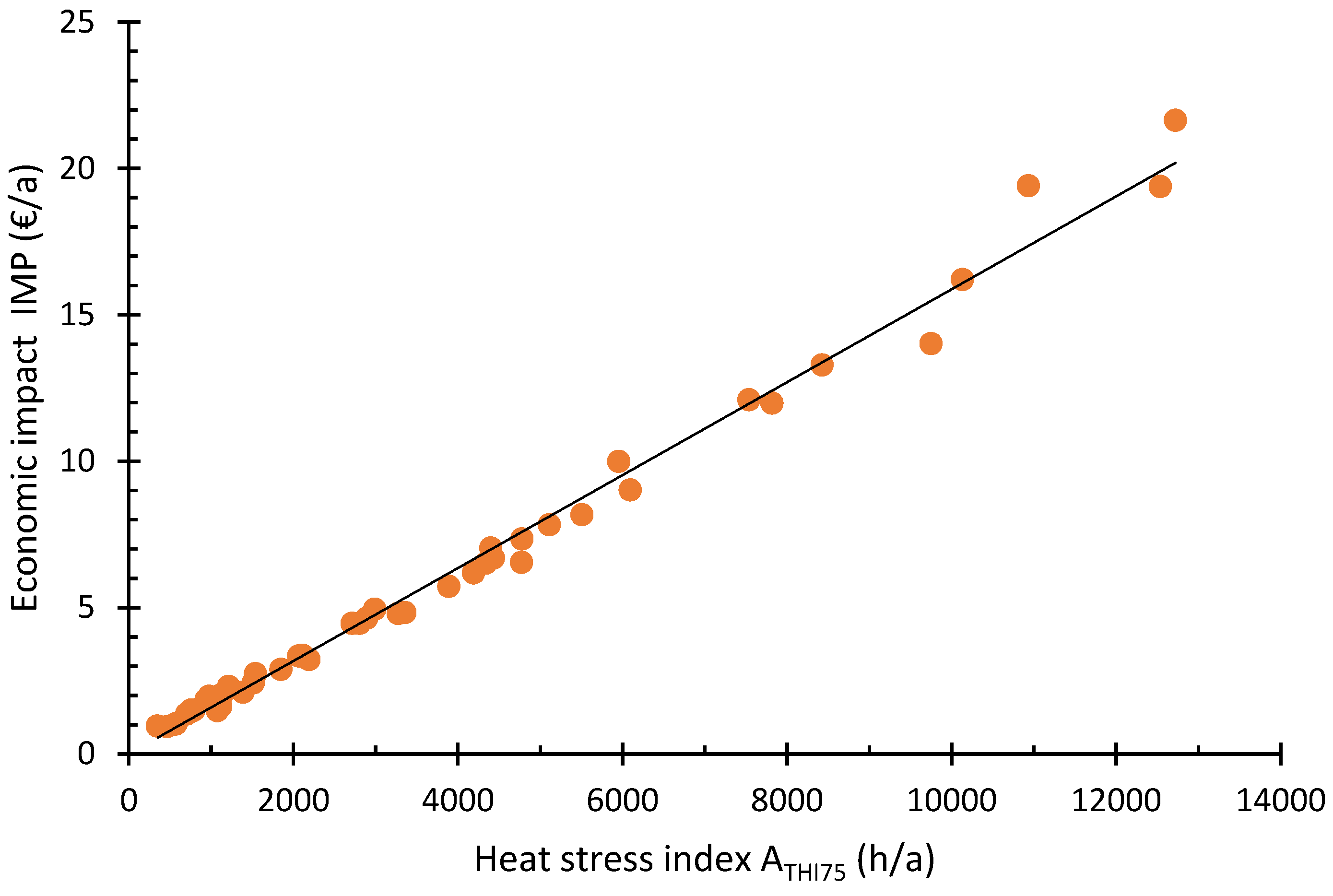
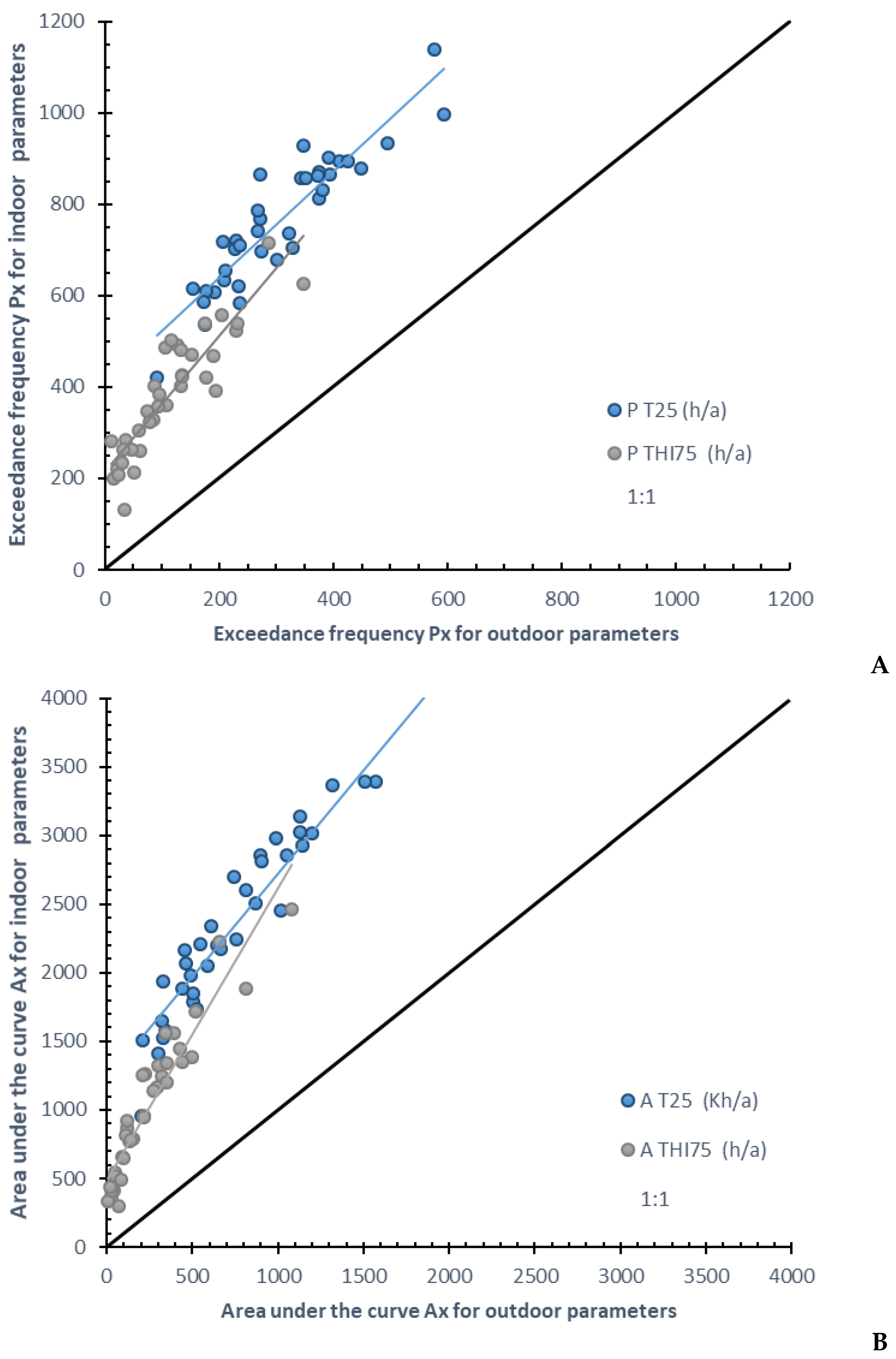
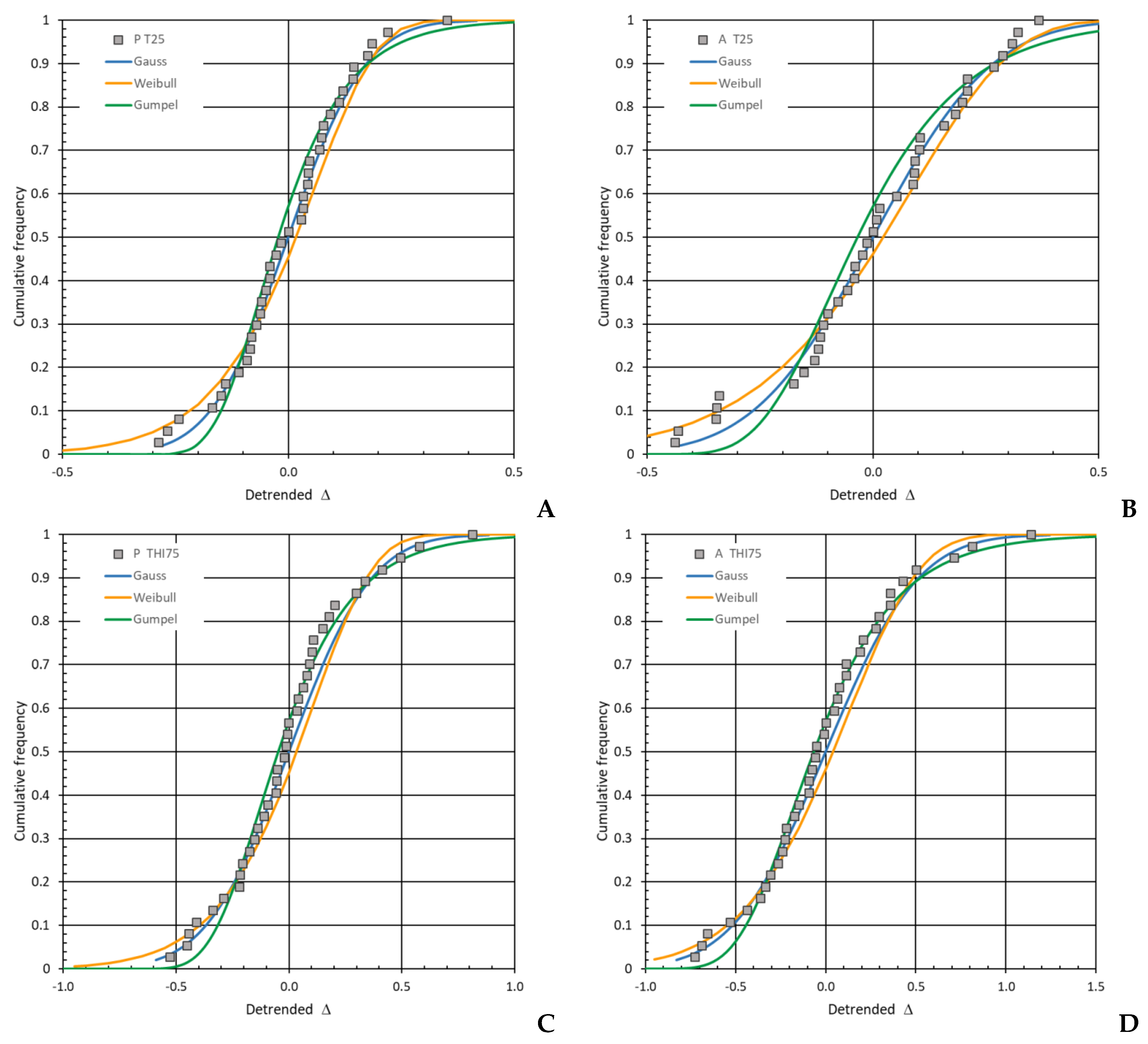
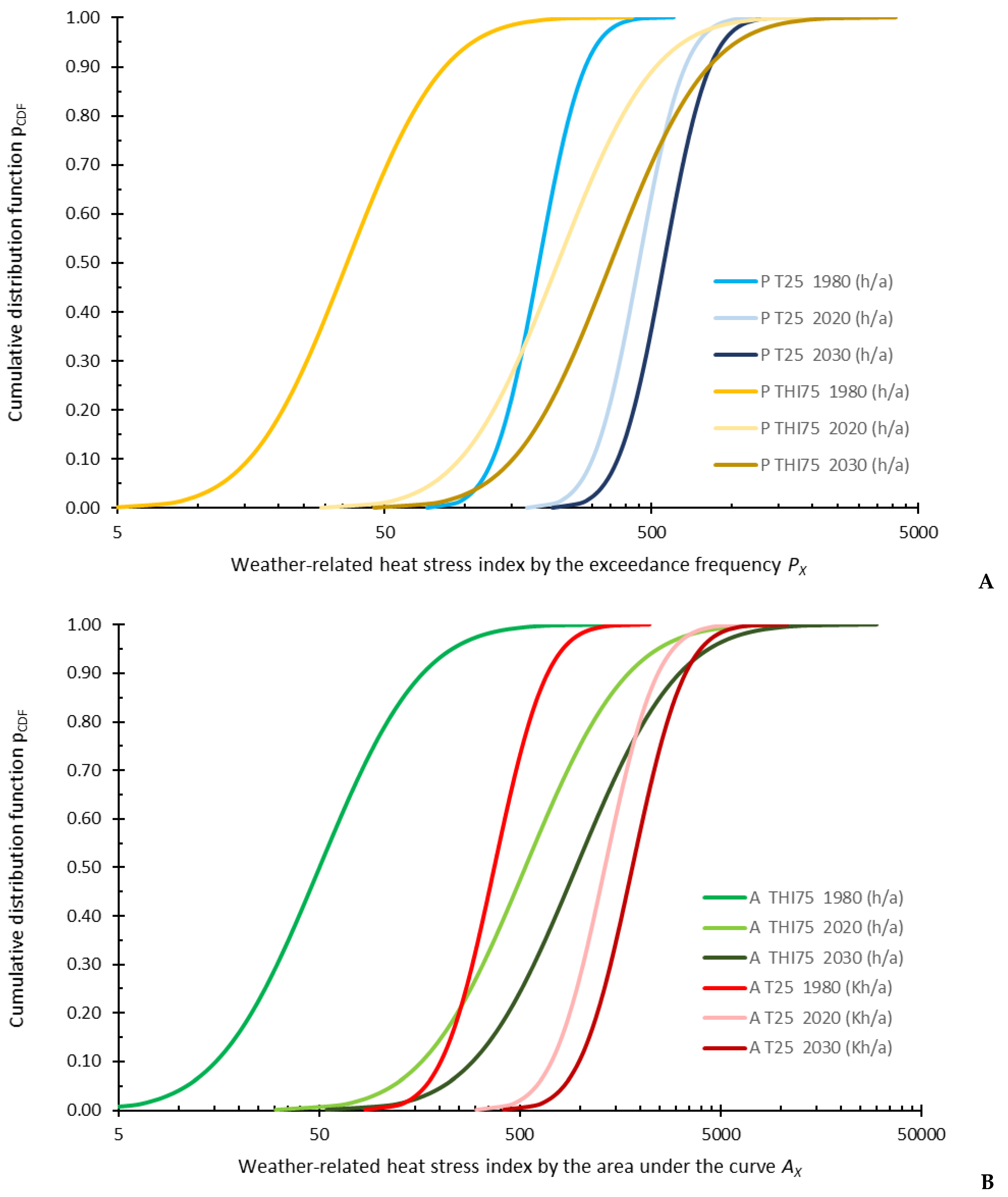
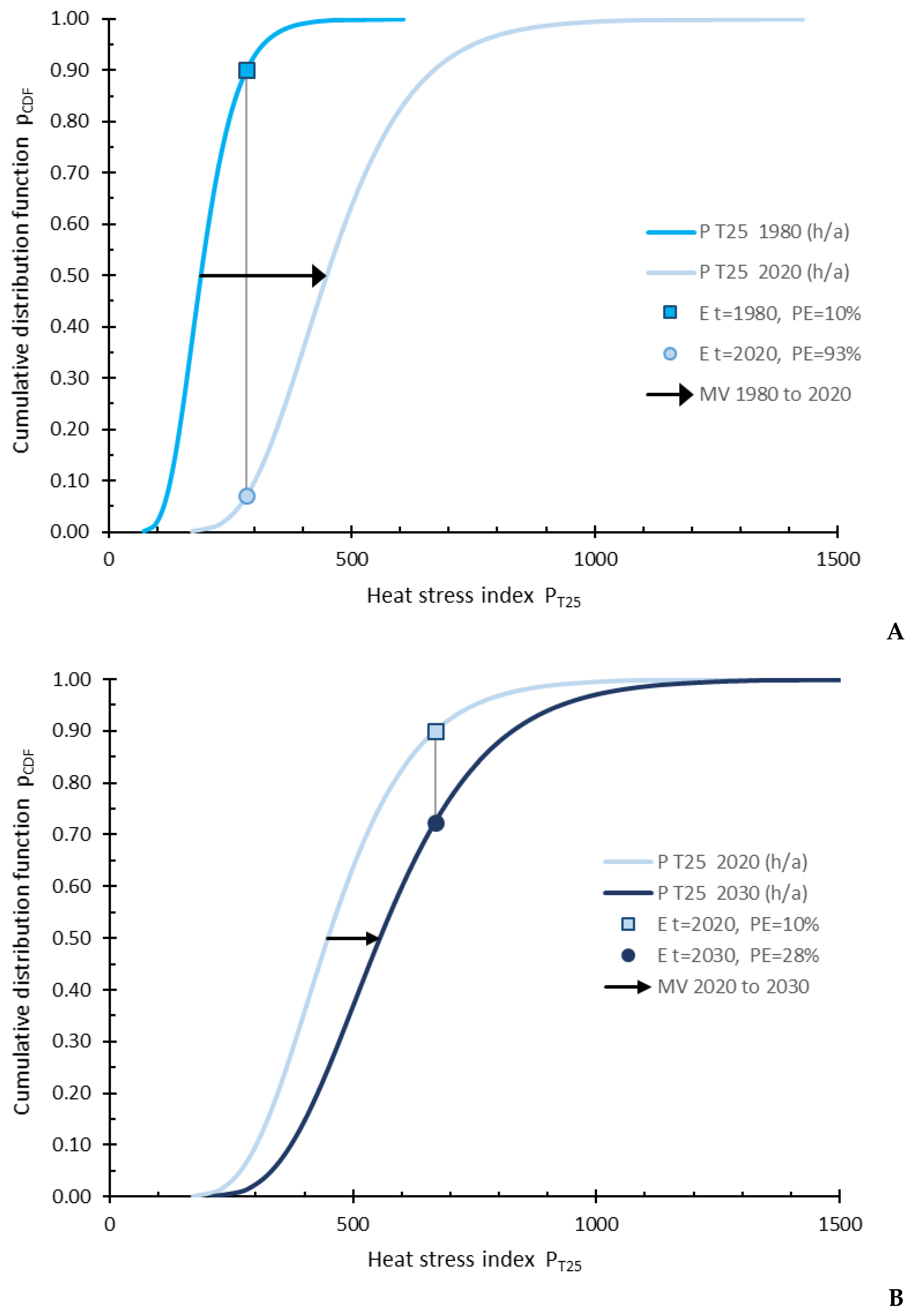
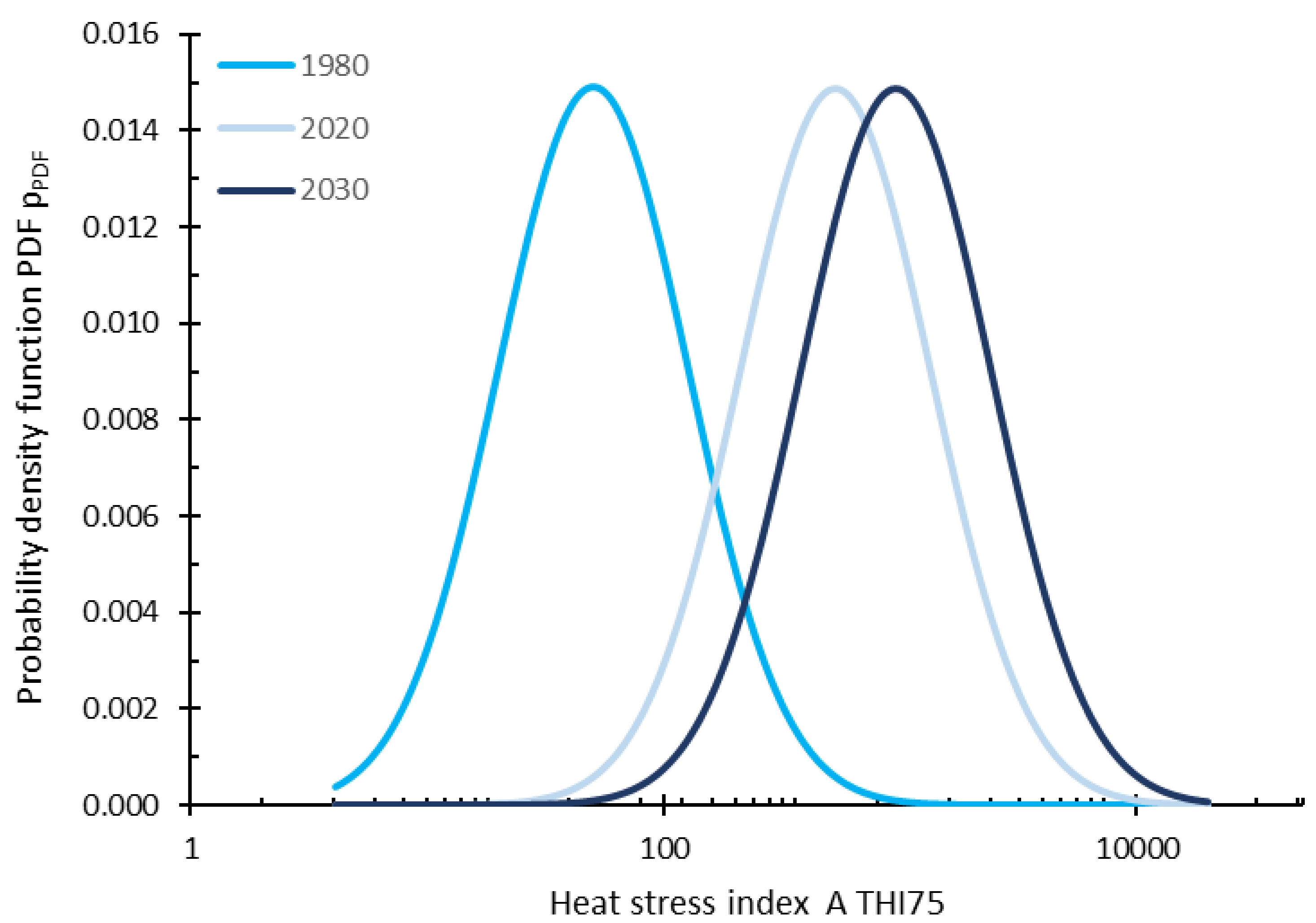
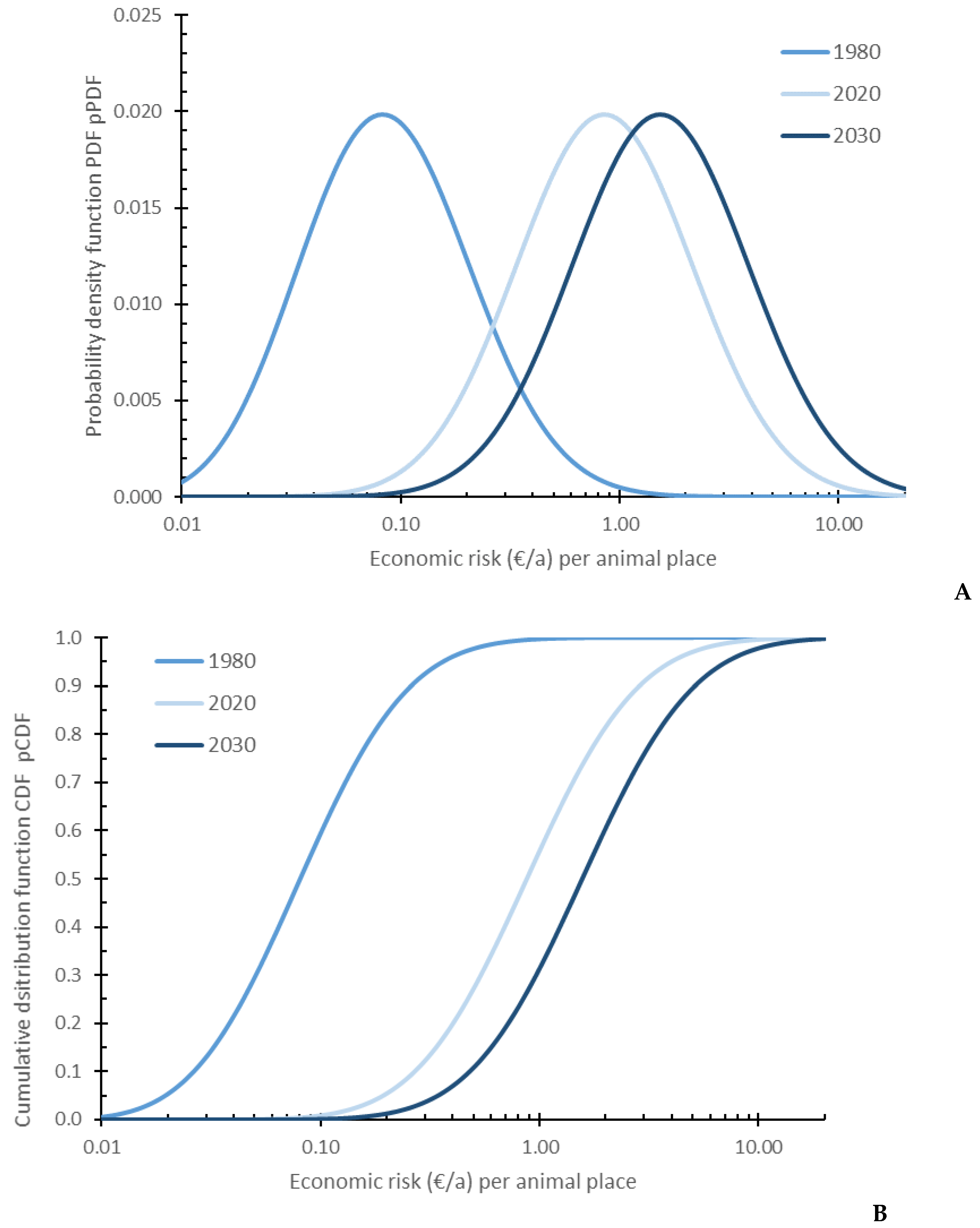
| Parameter | Value | |
|---|---|---|
| Animal | ||
| Body mass | 30–120 kg | |
| Service period (building emptied for cleaning and disinfection) per fattening period. | 10 days | |
| Building | ||
| Area of the building oriented to the outside (wall, ceiling, door, windows). | 1.41 m2 | |
| Mean thermal transmission coefficient weighted by the area of the construction elements (wall, ceiling, door, windows) which are oriented to the outside. | 0.41 W m−2 K−1 | |
| Ventilation system | ||
| Set point temperature of the ventilation control unit. | 16–20 °C | |
| Proportional range (band width) of the control unit. | 4 K | |
| Minimum volume flow rate of the ventilation system, for maximum CO2 concentration of 3000 ppm and a body mass of 30 kg [41]. | 8.62 m3 h−1 | |
| Maximum volume flow rate for a maximum temperature difference between indoor and outdoor of 3 K [41]. | 107 m3 h−1 |
| Heat Stress Index IINT | Coefficient of Determination Adjusted r2 | Linear Regression IINT = k IEXT + d |
|---|---|---|
| PT25 (h/a) | 0.8354 | =1.166 PT25 + 405.0 |
| AT25 (Kh/a) | 0.9084 | =1.505 AT25 + 1219.7 |
| PTHI75 (h/a) | 0.8032 | =1.495 PTHI75 + 212.9 |
| ATHI75 (h/a) | 0.8862 | =2.130 ATHI75 + 489.9 |
| Weather-Related Heat Stress Indices IEXT | Signal-to-Noise Ratio | Mann-Kendall Trend Test | ||
|---|---|---|---|---|
| SNR | p | τ | p | |
| PT25 (h a−1) | 2.001 | 0.023 | 0.4271 | <0.001 |
| AT25 (Kh a−1) | 1.790 | 0.037 | 0.3982 | <0.001 |
| PTHI75 (h a−1) | 2.071 | 0.019 | 0.4174 | <0.001 |
| ATHI75 (h a−1) | 1.832 | 0.033 | 0.3832 | <0.001 |
| Weather-Related Heat Stress Indices IEXT | Linear Regression of the Temporal Trend log It | |||
|---|---|---|---|---|
| Trend k | Intercept d | Coef Det r2 | p | |
| PT25 (h a−1) | 0.009326 | −16.187 | 0.333 | <0.001 |
| AT25 (Kh a−1) | 0.013745 | −24.643 | 0.314 | <0.001 |
| PTHI75 (h a−1) | 0.019806 | −37.658 | 0.334 | <0.001 |
| ATHI75 (h a−1) | 0.025600 | −48.987 | 0.296 | <0.001 |
| Weather-Related Heat Stress Indices ΔEXT | Standard Deviation s | AIC |
|---|---|---|
| PT25 (h a−1) | 0.1354 | −38.98 |
| AT25 (Kh a−1) | 0.2075 | −7.36 |
| PTHI75 (h a−1) | 0.2867 | 16.54 |
| ATHI75 (h a−1) | 0.4024 | 41.64 |
| Weather-Related Heat Stress Indices IEXT | Expected Values for p = 10% Et,10% | Exceedance Probability PE and Return Period RP | |||
|---|---|---|---|---|---|
| PE (%) | RP (a) | Shift of the MV | Shift % | ||
| Time shift from 1980 to 2020 | E1980,10% | for t = 2020 | |||
| PT25 (h a−1) | 283 | 93.0 | 1.1 | 258 | 136 |
| AT25 (Kh a−1) | 689 | 91.4 | 1.1 | 951 | 255 |
| PTHI75 (h a−1) | 84 | 93.1 | 1.1 | 188 | 520 |
| ATHI75 (h a−1) | 165 | 89.7 | 1.1 | 481 | 957 |
| Time shift from 2020 to 2030 | E2020,10% | for t = 2030 | |||
| PT25 (h a−1) | 668 | 27.7 | 3.6 | 107 | 24 |
| AT25 (Kh a−1) | 2442 | 26.8 | 3.7 | 493 | 37 |
| PTHI75 (h a−1) | 520 | 27.7 | 3.6 | 129 | 58 |
| ATHI75 (h a−1) | 1742 | 25.9 | 3.9 | 427 | 80 |
| Year t | Reduction of the Gross Margin (€ a−1) per Animal Place | ||
|---|---|---|---|
| Median | Weather VaR | ||
| 90-Percentile (10 a Return Period) | 95-Percentile (20 a Return Period) | ||
| 1980 | 0.08 | 0.27 | 0.38 |
| 2020 | 0.87 | 2.86 | 4.00 |
| 2030 | 1.57 | 5.13 | 7.18 |
Publisher’s Note: MDPI stays neutral with regard to jurisdictional claims in published maps and institutional affiliations. |
© 2021 by the authors. Licensee MDPI, Basel, Switzerland. This article is an open access article distributed under the terms and conditions of the Creative Commons Attribution (CC BY) license (http://creativecommons.org/licenses/by/4.0/).
Share and Cite
Schauberger, G.; Schönhart, M.; Zollitsch, W.; Hörtenhuber, S.J.; Kirner, L.; Mikovits, C.; Baumgartner, J.; Piringer, M.; Knauder, W.; Anders, I.; et al. Economic Risk Assessment by Weather-Related Heat Stress Indices for Confined Livestock Buildings: A Case Study for Fattening Pigs in Central Europe. Agriculture 2021, 11, 122. https://doi.org/10.3390/agriculture11020122
Schauberger G, Schönhart M, Zollitsch W, Hörtenhuber SJ, Kirner L, Mikovits C, Baumgartner J, Piringer M, Knauder W, Anders I, et al. Economic Risk Assessment by Weather-Related Heat Stress Indices for Confined Livestock Buildings: A Case Study for Fattening Pigs in Central Europe. Agriculture. 2021; 11(2):122. https://doi.org/10.3390/agriculture11020122
Chicago/Turabian StyleSchauberger, Günther, Martin Schönhart, Werner Zollitsch, Stefan J. Hörtenhuber, Leopold Kirner, Christian Mikovits, Johannes Baumgartner, Martin Piringer, Werner Knauder, Ivonne Anders, and et al. 2021. "Economic Risk Assessment by Weather-Related Heat Stress Indices for Confined Livestock Buildings: A Case Study for Fattening Pigs in Central Europe" Agriculture 11, no. 2: 122. https://doi.org/10.3390/agriculture11020122
APA StyleSchauberger, G., Schönhart, M., Zollitsch, W., Hörtenhuber, S. J., Kirner, L., Mikovits, C., Baumgartner, J., Piringer, M., Knauder, W., Anders, I., Andre, K., & Hennig-Pauka, I. (2021). Economic Risk Assessment by Weather-Related Heat Stress Indices for Confined Livestock Buildings: A Case Study for Fattening Pigs in Central Europe. Agriculture, 11(2), 122. https://doi.org/10.3390/agriculture11020122








